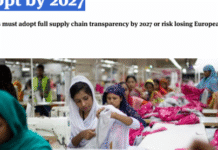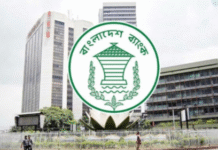The central bank says GDP growth will be around 6.2pc this fiscal year
The economy is likely to grow at a similar pace as experienced over the last ten years — of around 6.2 percent — in fiscal 2012-13, despite the continued global economic slowdown, Bangladesh Bank said yesterday.
“Most indicators in the first quarter of fiscal 2012-13 point to a more moderate level of economic expansion,” the BB said in its latest quarterly review.
The BB projection means that the growth is likely to fall short of the government's original target of 7.2 percent GDP growth for the current fiscal year.
“Bangladesh Bank will produce forecasts for economic growth on a regular basis, in line with the common practice in other central banks across the world,” said Hassan Zaman, its chief economist.
“We used recent data on economic activity and did forward-looking projections for the main sub-sectors of the economy,” he said.
Remittances grew by 19.7 percent in the July-September period of the current fiscal year, when in the same period last year it grew by 11.8 percent and by 10.2 percent on average in fiscal 2011-12.
“The significant remittance growth is likely to have positive consequences for both domestic consumption and investment.”
Private sector credit grew by 19.9 percent in the first quarter of FY13, on par with FY12's average of 19.9 percent.
While the annual development programme (ADP) utilisation of 12 percent in the first quarter this year is only slightly higher than the 11 percent recorded for the same quarter a year ago.
Export growth stood at 2.07 percent, down from last fiscal year's average of 6.2 percent and will continue to be so, mainly in light of the Eurozone crisis.
Meanwhile, imports grew by 2 percent, down from the 5.2 percent registered on average for the whole of FY12.
Given the “mixed picture” by the major factors associated with growth, the BB projected the economy to grow between 6.1 percent and 6.4 percent in the current fiscal year.
“This compares favourably with a developing country average forecast of 5.3 percent (World Bank 2012) for 2012.”
CPI inflation fell to 7.4 percent in the first quarter this year from 12 percent in the same quarter last year, with average inflation coming down to 9.69 percent in September 2012.
The decline in inflation was due to a slowdown in food inflation and the impact of monetary policy on non-food inflation and inflationary expectations.
“We expect the average inflation to decline further in FY13,” said the BB, adding that the prediction was made assuming no supply-side shock and the continued coordination between the monetary and fiscal policies.
“The first quarter witnessed three key developments related to monetary policy,” said the BB report.
The sharp increase in foreign remittances during the quarter (19.7 percent) and higher foreign aid disbursements contributed to a sharp rise in net foreign assets (27 percent over the quarter).
While this favoured a reserve build-up close to four months of import cover, it also led to some over-shooting of monetary targets.
The second key development relates to the sharp decline in inter-bank rates, which fell from 15 percent in June 2012 to 9.81 percent by the end of September, and from a peak of 19.66 percent in January 2012.
“This confirms the ample liquidity prevailing in the banking system and as such, the BB is seeking to sterilise some of this liquidity to avoid a re-emergence of inflationary pressures.”
The third development centres around the healthy growth in private sector credit, which during the first quarter this year grew by 19.9 percent against a target of 18.4 percent. This suggests that the credit envelope will “not be a constraint towards achieving the overall economic growth targets”.
The National Board of Revenue's tax collections were 12.8 percent higher than raised in the first quarter and 18.6 percent of the budgeted amount for the whole of FY13.
Higher revenue inflows from direct taxes (22.7 percent increase) and value-added tax (15.7 percent increase) accounted mainly for the positive first quarter performance.
“On the whole, public finance's tax collections appear to be broadly on track.”
Meanwhile, the total government expenditure in the first quarter increased by 24.6 percent compared to the same period last year. Within these outlays, ADP expenditures rose by 32 percent.
In the external sector, the current account balance turned into a surplus of $140 million during the quarter against a deficit of $10 million in the same period a year ago.
Remittance inflows increased by a 'remarkable' 19.7 percent to $3.56 billion during the period compared to $2.97 billion during the same period last year and more than covered the trade deficit of $2 billion and the deficit in other current services.
This surplus combined with a surplus in the capital account contributed to an overall balance of payment surplus of $1.1 billion in the quarter against a deficit of $100 million in the same quarter last year.
As a result, gross foreign international reserves rose to $11.25 billion at the end of the first quarter this year compared with $9.88 billion in the same period last year.
The foreign exchange market remained mostly stable during this period with the taka appreciating by 0.21 percent against the US dollar during the quarter.
Gross domestic agricultural production is expected to be 2.2 percent higher than that of the previous year, of 65.6 million tonnes, on the back of government incentives and higher agricultural credit disbursement.
“We also assume that the effective fertiliser supply and better seed distribution seen in recent years will continue, and contribute to achieving an agricultural growth rate of between 3.50 percent and 3.75 percent in fiscal 2012-13.”
The industrial sector is projected to grow between 7.5 percent and 7.75 percent in fiscal 2012-13, down from the 9.47 percent seen last fiscal year, but in line with the average industry sector growth rate over the last ten years.
Source:The Daily Star










